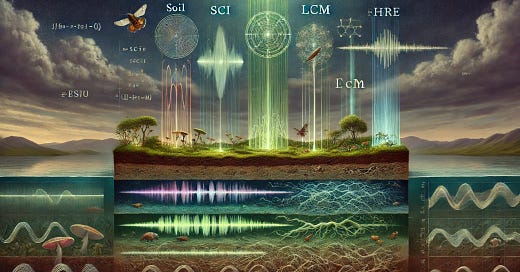#147: From Biological Whispers to Ecosystem Intelligence: How Multi-Layer Signal Processing Predicts Environmental Collapse
Part of the Series: Listening to Nature – Building Fire-Resilient Landscapes - 6(i)
In previous posts (#143–146), we explored how ecosystems quietly signal stress long before collapse becomes visible. Each ecological layer—soil, insects, birds, and amphibians—functions like a biological sensor, revealing environmental strain through subtle but measurable changes.
For example:
Soil dries silently, with fungal networks retracting when moisture falls below 20% VWC and root capacitance declining as xylem tension rises to -1.5 MPa.
Insects like katydids lower their call frequency from 40 kHz to 20 kHz as drought intensifies, often 30–45 days before plants show visible stress.
Birds simplify their songs when habitat dries, with dawn chorus complexity dropping by 40% and migratory patterns shifting as water bodies shrink.
Amphibians compress their call windows from 6 to 2 hours as moisture disappears, clustering near the last remaining water sources.
These signals, while powerful, remain fragmented without a framework to integrate them into actionable intelligence. That’s where the Sensorial Matrix comes in—a system that not only listens to these whispers but translates them into predictive insights.
🚨 Before We Dive In: Two Quick Notes
1- Why These Concepts Matter: This post involves technical details, so understanding the rationale behind the approach will make it easier to follow.2- Post Structure: Due to length, this exploration is split into two parts. Today’s post covers Sections 1–4, while Sections 5–7 will follow in the next.Why Mathematical Modeling?
Ecological stress signals, like drying soil or simplified bird songs, often seem random when viewed in isolation. But ecosystems don’t collapse suddenly—they unravel when resilience silently erodes across multiple layers.
To catch this unraveling, we need to move from fragmented observations to a quantifiable system—what I call the Living Algorithm. This system tracks stress signals, weighs their significance, and predicts tipping points before collapse becomes visible.
At its core, the Living Algorithm converts biological signals into a stress equation:
ES(t,x,y) = ∑[ωᵢ(t)Sᵢ(t,x,y)] × ∏[1 + δⱼ(t)Cⱼ(t,x,y)] × Φ(t,x,y)In simple terms:
Why weights (ωᵢ)? Because stress signals aren’t equally important. A 5% soil moisture drop matters more in arid zones than in wetlands.
Why cross-layer coupling (δⱼ)? Because stress cascades. Dry soil weakens plants, reduces insect calls, and alters bird migration.
Why phase synchronization (Φ)? Because resilience relies on biological rhythms staying in sync. When species fall out of step, collapse follows.
Why Exponential Decay and Sinusoidal Terms?
Stress doesn’t rise linearly—it accelerates under pressure and fades gradually when conditions improve. That’s why equations often include exponential decay and sinusoidal rhythms.
For example, the stress complexity function:
C(t) = C₀ × exp(-λt) × [1 + ξ(t)]Here's why:
Why baseline complexity (C₀)? It defines healthy conditions—like a bird’s normal song pattern.
Why exponential decay (exp(−λt))? Because ecosystems degrade progressively, not instantly, under stress.
Why environmental noise (ξ(t))? Because real-world stress is messy, influenced by fluctuating factors like temperature and humidity.
Similarly, sinusoidal terms like sin(2πt/T) capture seasonal rhythms. Katydid calls naturally rise during the rainy season and fall during dry months. Incorporating these cycles ensures the Sensorial Matrix distinguishes natural variations from true stress responses.
Why Does This Matter? From Observation to Prediction
Imagine a grassland under moderate drought. Soil moisture drops from 25% to 18%, but the landscape still looks green. Katydids lower their call frequency to 25 kHz, bird songs simplify by 30%, and frogs shorten their calls to 3 hours nightly.
To a casual observer, nothing seems urgent. Yet, the Sensorial Matrix detects a clear pattern: cross-layer synchronization, signaling resilience is unraveling. The stress score crosses a critical threshold, triggering an Early Warning Alert—buying 10 to 14 days before visible collapse.
This predictive power transforms ecological monitoring from passive observation to proactive intervention.





